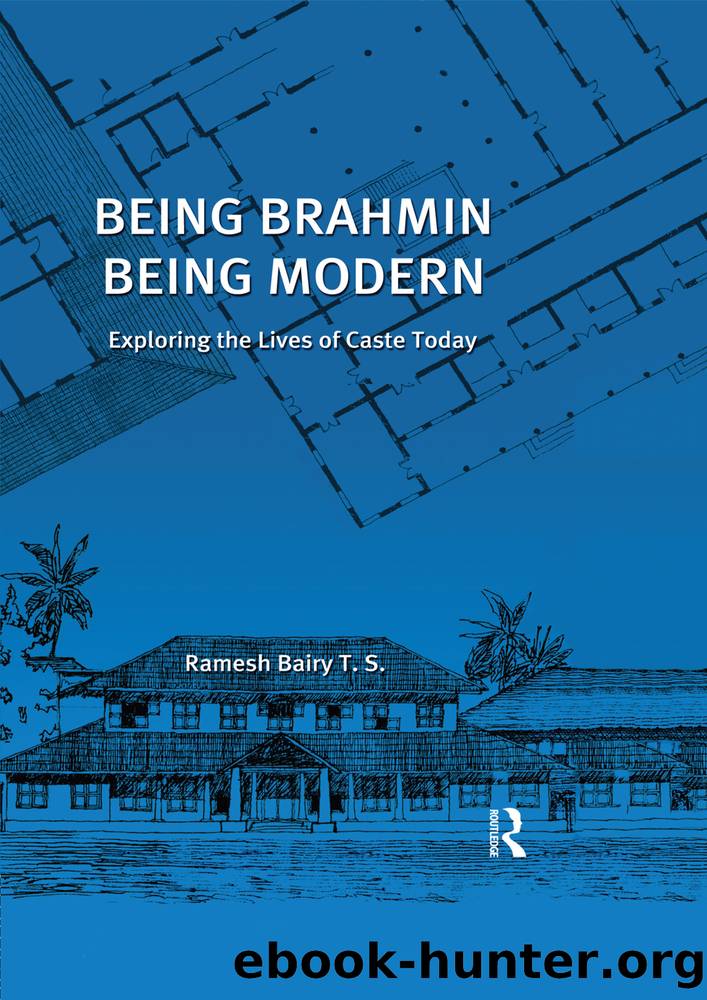Being Brahmin, Being Modern by Ramesh Bairy

Author:Ramesh Bairy [Ramesh, Bairy T. S.]
Language: eng
Format: epub
ISBN: 9781136198199
Publisher: Taylor and Francis
Published: 2022-06-15T00:00:00+00:00
Shifting Articulations: Corporate and Jati Associations
This section details the varied logics of corporate and jati associations. I begin with the pioneering efforts of the 1940s and devolve upon the contexts in which AKBMS emerged. The axis of this reexamination is then counterposed to the trajectory and concerns of jati associations.
The registers of identity animating the corporate associational activities of the 1940s point to the deeply contested space that an association wishing to speak for the Brahmins was seeking to inhabit. For the Brahmin, this space comes overdetermined in its meanings, possibilities and legitimacies, and is largely inimical at that. It is a field that the ânon-Brahminâ had made his own, acquiring legitimacy by defining himself in opposition to the figure and persona of the Brahmin, and deploying the associational space as a crucial medium to enunciate this subjectivity. The modern state (and in some senses, the growing dominance of the ethos and ethics of modernity itself) readily agreed to play by those very terms. What is more, an increasing number of Brahmins began to interrogate the state of being Brahmin and, thereby, came to form a complex relationship with the efforts being made to bring Brahmins together under the umbrella of associations. Primarily, the Brahmin persona that was resurrected by the associations in the wake of these complexities had to be vested with greater moral force, energy and legitimation. In doing so, this self-imagination had to evade an exclusive focus on the âmaterialityâ of the community (in terms of its demands for resources) and instead foreground a normatively appealing Brahmin. However, this elision works to subvert the very imperative of caste associationsâof seeking to work towards improving the material conditions of the community. In an attempt to strike a balance between these two incompatible pulls, the non-Brahmin attack is itself made to work towards justifying the emergence of Brahmin associations. As we will see below, hostility to state intervention for social justiceâe.g., through reservationsâalso provided a ground for articulating the need to come together.
Accordingly, the first resolution passed at the Dharwad Convention of 1940 was that the âBrahmin class has a special responsibility to protect the sanatana samskriti [eternal culture]â. The President of the convention had this to say:
The ultimate goal of the Brahmin class is to work to realise the dictum, sarvejanaha sukhinobhavanthu [welfare of all]. His contribution to this task is through gaining the riches of meditation. But, for that to come true, there ought to be a conducive environment in the country which sadly does not exist todayâ¦.We have always held steadfast the belief that the varnashrama dharma is the most protective of the stability of our society. Just because the varnashrama system builds the society on the basis of birth, it does not mean that it belittles qualities/character. A Brahmin without character is inappropriate. Let us not give unnecessary prominence to the accident of birth; but neither shall we accord it an unnecessarily lowly status. Our ultimate aim is to fulfil the brahminness that is there available to us at birth, through our character.
Download
This site does not store any files on its server. We only index and link to content provided by other sites. Please contact the content providers to delete copyright contents if any and email us, we'll remove relevant links or contents immediately.
Cecilia; Or, Memoirs of an Heiress — Volume 1 by Fanny Burney(32059)
Cecilia; Or, Memoirs of an Heiress — Volume 3 by Fanny Burney(31455)
Cecilia; Or, Memoirs of an Heiress — Volume 2 by Fanny Burney(31406)
The Great Music City by Andrea Baker(30780)
We're Going to Need More Wine by Gabrielle Union(18630)
All the Missing Girls by Megan Miranda(14719)
Pimp by Iceberg Slim(13777)
Bombshells: Glamour Girls of a Lifetime by Sullivan Steve(13683)
Fifty Shades Freed by E L James(12909)
Talking to Strangers by Malcolm Gladwell(12867)
Norse Mythology by Gaiman Neil(12821)
For the Love of Europe by Rick Steves(11448)
Crazy Rich Asians by Kevin Kwan(8886)
Mindhunter: Inside the FBI's Elite Serial Crime Unit by John E. Douglas & Mark Olshaker(8699)
The Lost Art of Listening by Michael P. Nichols(7159)
Enlightenment Now: The Case for Reason, Science, Humanism, and Progress by Steven Pinker(6871)
The Four Agreements by Don Miguel Ruiz(6312)
Bad Blood by John Carreyrou(6274)
Weapons of Math Destruction by Cathy O'Neil(5828)
